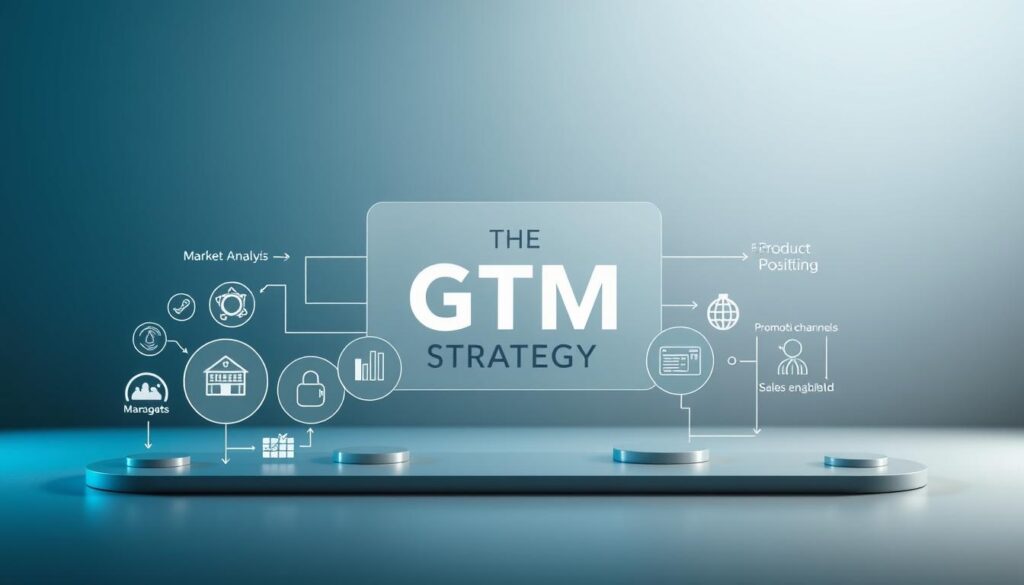In the business world today, using AI-powered GTM for product launches is key. AI marketing solutions change the game, making market research and understanding customers easier.
AI technology also lets businesses fully analyze competitors. This helps them stay on top of trends. As companies embrace these new solutions, it’s clear that using AI is crucial for staying competitive.
Key Takeaways
- AI-powered GTM strategies are revolutionizing product launches.
- Utilization of AI marketing solutions streamlines essential research processes.
- AI technology enhances customer insights for better decision-making.
- Competitive analysis can now be conducted with advanced AI algorithms.
- Companies adopting AI solutions are better positioned in competitive markets.
Understanding AI in Product Launches
AI plays a key role in making product launches better. It helps companies understand the market and beat the competition. With AI, businesses can get insights and analyze market trends more effectively.
The Role of AI in Market Research
AI makes market research faster by handling big data quickly. It looks into trends, what customers like, and new market changes. These insights help businesses make smart choices. They spot chances and gaps in the market.
How AI Enhances Customer Insights
AI gives a deeper look into what consumers want. It finds patterns in consumer data that are hard to see otherwise. This helps in creating marketing that truly speaks to customers, boosting loyalty and interaction.
AI-Driven Competitive Analysis
AI simplifies knowing what competitors are doing. It uses automated tools to keep an eye on their moves and products. This detailed info helps businesses stay ahead in the game. They can adapt and compete better.
Key Components of a GTM Strategy
To make a GTM strategy work, companies need to focus on a few main parts. They must identify who will most likely buy their product. This helps make sure their offers are tailored correctly. They must also explain why their product is different and better than others. Plus, it’s crucial to show the product’s benefits clearly. This makes it more appealing to customers.
Defining Target Market Segments
Knowing who your target market is, is key for a GTM strategy. This means figuring out who potential customers are based on things like age, habits, and what they need. It lets businesses use their marketing money wisely. By knowing each segment’s needs, companies can customize their messages, making a product launch more likely to succeed.
Establishing Unique Selling Propositions
Having a unique selling point (USP) helps a product stand out. A good USP shows what’s special about a product, making it more attractive. It’s important for talking to the right customers and keeping them interested. Spending time on creating strong USPs helps attract and keep customers, which boosts sales and growth.
Creating a Value Proposition
A clear value proposition is essential for a GTM strategy. It explains how a product solves problems while highlighting its unique benefits. To do this well, you need to really understand what customers need and want. A strong value proposition attracts potential buyers and helps sales teams share product benefits, making the launch smoother.

Leveraging AI for Market Segmentation
Launching successful products needs effective market segmentation. Using AI, businesses can dive deep into customer data. This way they find insights that old methods might miss. It allows for marketing that truly speaks to certain consumer groups.
Techniques for Data Collection
Gathering data is key for segmenting the market right. By using customer data platforms (CDPs), companies can organize and clean data from different sources. They can look at how people interact on websites, fill out surveys, and engage on social media. This gives a full picture of who their audience is.
AI Algorithms for Segmentation
After collecting data, AI algorithms take the stage in marketing. They’re great at finding patterns and trends in the data. They look at who people are and what they do to create clear market segments. This lets companies target their messages and products to the right groups.
Case Studies on Successful Segmentation
Many companies have seen success by using AI for market segmentation. For example, one used machine learning to better target customers. This cut down on wasted marketing and made customers more engaged. These examples show that AI can really fine-tune market segmentation, making product launches do better. Those interested can learn more by reading a detailed guide.
Developing Personalized Marketing Campaigns
Today, it’s key to make marketing campaigns personal to truly engage consumers. By using AI, marketers can craft messages that hit the mark with each person’s likes and habits. This approach doesn’t just get more people involved; it also makes customers happier.
AI Tools for Personalized Content
AI has changed the game for creating content that speaks directly to users. It looks at the data on what consumers do and like, giving insights for unique marketing messages. With tech like natural language understanding and learning from patterns, businesses can reach many with content that feels one-of-a-kind. For example, creating unique emails and web pages automatically can engage users more deeply. By this, using AI for crafting personal content makes marketing smoother and more effective.
Automated Outreach Strategies
With automated strategies, reaching out to people becomes more straightforward. Brands segment their audience and automate sending them info, making sure it fits what they’re interested in. They use AI to see what works, saving time and getting people more involved. This approach helps in understanding and reacting to what customers do and want quickly. So, it shows why chatting in a more personal way is crucial in marketing today.
Measuring Campaign Effectiveness
To keep getting better, checking how well personalized marketing does is a must. Marketers should watch metrics like how much people engage, convert, and what they say. Looking at these numbers helps see how personalizing messages changes things and guides the next steps. By fine-tuning methods with AI analyses, companies grow and connect better with their customers.

Utilizing Predictive Analytics in Pricing
Today, using predictive analytics in pricing is crucial for companies wanting to improve their earnings. Through dynamic pricing models, businesses can change prices based on factors like market demand, what competitors charge, and how customers act. This method boosts pricing strategies and profits.
Setting Dynamic Pricing Models
Dynamic pricing means changing prices using real-time data and market situations. Firms apply algorithms analyzing lots of data, to find the best prices. Travel, hospitality, and online shopping industries often use these models. They attract customers and stay competitive.
AI in Demand Forecasting
AI in demand forecasting is key to better pricing methods. It looks at past sales, trends, and market situations. Then, AI makes accurate demand predictions. This lets businesses price things smartly, matching what customers expect and following market trends.
| Dynamic Pricing Models | Description | Industries |
|---|---|---|
| Surge Pricing | Prices increase during high demand periods. | Ride-sharing, Events |
| Time-Based Pricing | Prices adjust based on the time of purchase. | Airlines, Hotels |
| Value-Based Pricing | Prices reflect the perceived value to the customer. | Luxury goods, Software |
| Competitor-Based Pricing | Prices adjust based on competitor prices. | Retail, E-commerce |
By bringing predictive analytics into pricing and adopting dynamic pricing, companies improve their efficiency and profit. AI demand forecasting gives insights that help them stay ahead in the fast market today.
Enhancing Product Development with AI
Adding AI to product development changes traditional ways for the better. It makes the process faster and more in tune with needs. Teams use smart systems to keep improving their products. They use user feedback cleverly, making updates that matter based on what data tells them.
Feedback Loop Integration
Setting up good feedback loops is key for making great products. These loops help continually collect what users think. Thanks to AI, gathering and using feedback is automated. This means products get better, quicker, in ways people want.
Identifying Product Improvements
AI helps figure out how to make products better. It looks at how users act and what they say they need. With machine learning, a ton of data turns into useful tips. These tips help fix issues and find new ways to be innovative.
Agile Methodologies and AI
Using AI with agile methods makes making products faster and more adaptable. Teams can work in quick cycles, always improving. AI helps decide what to focus on next, based on real feedback. This blend of AI and agile means products always meet people’s needs well.
Real-Time Monitoring of Launch Performance
For businesses aiming high, monitoring launch performance in real-time is key. Knowing how well a product meets its goals helps teams a lot. By using AI, companies can quickly respond to changes in the market.
Key Metrics to Track
To know if a launch works well, businesses must watch certain metrics. Here are some vital ones:
- Sales Volume: Tracks the number of units sold within a specific period.
- Market Penetration: Measures the product’s share relative to the total potential market.
- Customer Acquisition Cost: Evaluates the cost associated with acquiring new customers.
- Customer Feedback: Collects insights from users to refine products and strategies.
Adjustments Based on AI Insights
AI insights greatly help in making smarter launch decisions. It allows for fast changes by looking at data and predicting outcomes. For example, if people like a feature, teams can focus on making it better. Regularly checking key performance metrics boosts launch results and aids in planning for the future.
Using advanced AI technology makes this easier, giving businesses solid advice to better their strategies.
To learn more about how AI changes financial modeling and predictions in sales, check out this resource.
The Future of AI in GTM Strategies
The future of AI in GTM strategies looks really bright as more businesses use tech in their plans. AI trends are changing the game with better customer insights and analytics. This means brands can really understand what their customers want. Innovations in how machines learn and process our language are making a big difference. They help companies talk to their customers in a more personal way, leading to better experiences.
Companies must get ready now for the AI changes that are coming. They need to be flexible and use AI tools that can keep up with new trends. They also should teach their teams how to use these new AI technologies. This will help them stay ahead in their industry. By doing this, companies can work more efficiently. They can quickly adjust to what their customers are doing.
In the end, AI will change how we create and run marketing campaigns. It will make things more effective by pulling customers in better. As everything evolves, knowing about AI in GTM strategies will be key. Companies that understand this will keep growing and innovating in a world that’s becoming more digital.
FAQ
What is an AI-powered go-to-market (GTM) strategy?
An AI-powered GTM strategy uses artificial intelligence to make product launches better and more efficient. It applies AI to study the market, learn about customers, and check out competitors. This helps businesses to remain ahead.
How does AI improve market research for product launches?
AI makes market research better by quickly analyzing lots of data, spotting trends, and giving fast insights. This helps companies make smart choices with the latest, most accurate information.
In what ways can AI enhance customer insights?
AI boosts customer insights by spotting patterns in what customers do and like. This leads to marketing that hits the mark better, engages more, and gets better results when launching products.
Why is defining target market segments crucial in a GTM strategy?
Pinpointing target market segments lets businesses position their products just right. It means they can shape their products and marketing to meet specific customer needs well, which boosts sales.
What role do AI algorithms play in market segmentation?
AI algorithms use behavior and demographics to pinpoint market segments very accurately. This sharp targeting helps companies market in a way that speaks directly to their audience, improving launch results.
How can businesses develop personalized marketing campaigns using AI?
Companies can use AI to tailor content that matches customer likes and habits. They can then reach out in a way that’s more likely to engage and win over potential buyers.
What is the significance of predictive analytics in pricing strategy?
Predictive analytics allow for pricing that changes with market demand and how competitors price. It uses past sales data to guess demand, helping companies set prices smartly based on data.
How does AI contribute to the product development process?
AI boosts product development by incorporating customer feedback and using data analysis for product betterment. It encourages quick and adaptive development, speeding up the process.
What metrics should businesses monitor during product launches?
During product launches, companies should watch customer engagement, how well conversions are happening, and sales. AI helps make sense of these numbers to refine strategies and get better results.
What are some emerging trends in AI technology for GTM strategies?
New trends are better machine learning, advanced predictive analytics, and finer customer segmentation. Keeping up with these trends lets companies tweak their marketing to stay on top.



